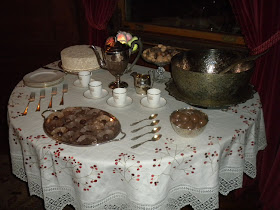Special Christmas Candlelight Tours of both the Clarke and Glessner house museums focusing on Christmas traditions will be offered the weekend of December 8th and 9th, with tours at 5:30, 6:00, and 6:30pm each evening. For more information, click here. Pre-paid reservations are required and may be made by calling 312-326-1480 .
In her journal, Frances Glessner records the following information about Christmas Day 1895:
“Wednesday morning we had our Christmas pie – exchanging small gifts – and having a very merry time together. The Ream girls were over after breakfast. John gave me money – George gave me a stylographic pen – Frances a silver tape needle – John a silver tape needle – Mr. and Mrs. Moore a book.
“Miss Allport, Miss Cooley, Mrs. Herrick, Mr. Armour, Mrs. Moore sent me flowers.
“In the evening, Mr. Hendricks, Mr. Badger, Mr. Marsick came to dinner (joining the four Glessners and Mr. and Mrs. Moore, who had been staying at the house since Tuesday). Prof. Hendrickson of the University at Madison University of Chicago Frances Frances Frances
Frances Glessner recorded the menu in her dinner book. The meal consisted of eight courses as follows:
1st course – oysters on the half shell, brown bread, and butter
2nd course – clear soup, sherry
3rd course – mold of fish, potatoes, cucumbers, champagne, and cider
4th course – chicken timbale (a custard like dish of cheese and chicken baked in a drum-shaped pastry mold)
5th course – turkey, sweet potatoes, chestnuts, celery, jelly, cranberries, and pickles
6th course – salad
7th course – plum pudding and mince pie
8th course – fruits, nuts, raisins, figs, cake and coffee
Of particular interest is one of the guests at the Christmas dinner, Martin Pierre Marsick. The Glessners first met Marsick on Sunday December 21, when their friend Miss Millar telephoned to know if she might bring Mr. Marsick up to call. The Glessners immediately said yes. At that initial meeting, Frances Glessner wrote that “Mr. Marsick was extremely pleasant, played and sang, and talked.”
Martin Pierre Marsick (1847-1924) was a Belgian violin player, composer, and teacher. His violin, made by Antonio Stradivari in 1705, has since become known as the Ex Marsick Stradivarius. (It was later used by violinist David Oistrakh in the 1960s and 1970s).
Marsick graduated with a gold medal from the Royal Conservatory of Music in Liège in 1865. In 1871, he joined the newly established Société Nationale de Musique in Paris Europe and the United States








